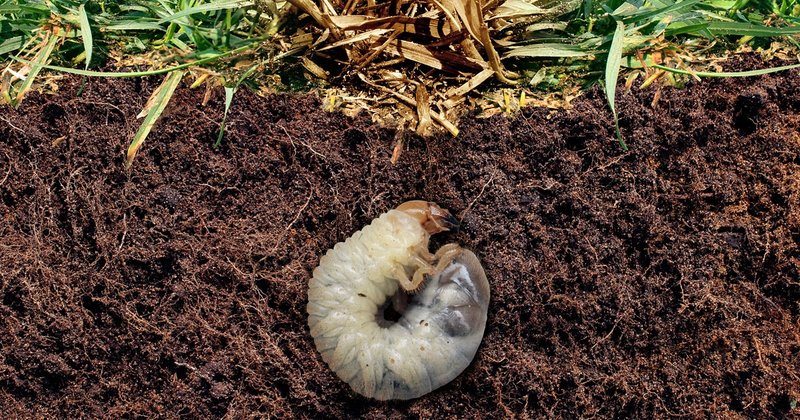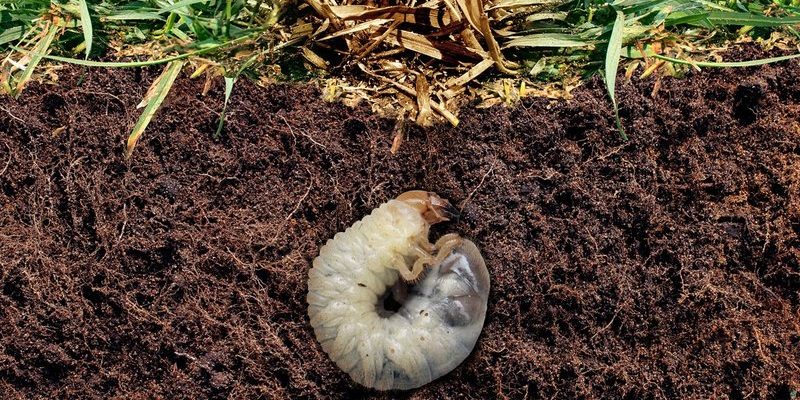
Think of your lawn as a stage. If grubs are the uninvited guests who sneak in during the performance, applying grub control treatments is like having the right bouncer at the door, keeping things safe and sound. This guide will take you through the best times to treat for grubs, how these treatments work, and what to look for in a good product.
Understanding Grubs and Their Impact on Your Lawn
Before diving into treatments, it’s important to understand *what* grubs are and why they can be so damaging. Grubs are the larvae of various beetles, like the Japanese beetle. They thrive underground, munching on grass roots and other plant material. If your lawn is a buffet, grubs are the hungry diners who never leave the table!
You might be wondering how to recognize grub damage. Look for brown patches that seem to be wilting or dying. If you pull up a section of grass and it comes up easily, that’s a telltale sign. And if you spot more than five grubs per square foot underneath that sod, it’s time to take action before your lawn turns into a patchy mess.
Grubs are most active in late summer and early fall, so keeping an eye on your lawn during these months is crucial. If you can catch them early, you’ll save your grass from significant damage. That’s where grub control treatments come into play.
Best Times to Apply Grub Control Treatments
Timing is everything when it comes to grub control treatments. The most effective time to treat for grubs is during their vulnerable stages, which typically falls in late summer and early fall. But why specifically these times?
In late summer, grubs are young and close to the surface, making them easier targets for treatments. Plus, they start to move to the surface of the soil as temperatures cool, and that’s when they become incredibly active. Applying grub treatments during this time allows the product to work effectively against the younger grubs.
Moving into early fall, when temperatures are still mild, is another ideal window. At this point, grubs are preparing for winter, and a treatment can prevent them from maturing and causing damage next year. Honestly, if you miss the window in late summer, treating in early fall can still give you a fighting chance.
Types of Grub Control Treatments
Not all grub control products are created equal. There are primarily two types you should consider: preventatives and curatives.
**Preventative treatments** work by creating a barrier in the soil that prevents grubs from establishing themselves. An example of this is products containing *imidacloprid* or *chlorantraniliprole*. Applying preventatives before adult beetles lay their eggs (usually in late spring) is key for success.
In contrast, **curative treatments** are designed to target existing grubs. If you’ve spotted them already, opt for curative formulas with ingredients like *trichlorfon*. These products work quickly to kill off grubs that have already taken up residence in your lawn. Choosing the right treatment depends on whether you’re trying to prevent or treat a grub problem.
How to Apply Grub Control Treatments
Applying grub control treatments is fairly straightforward, but there are steps you should follow for the best results. First, check the weather. Ideally, you want to apply your treatment when rain is expected within a couple of days. This helps the product penetrate the soil and reach the grubs more effectively.
Next, calibrate your spreader. This may seem like a small detail, but using the correct setting ensures that you’re applying the right amount of product. Too little might not do the job, while too much can harm your lawn.
Once you’ve set your spreader, walk steadily across your lawn, applying the treatment in a crisscross pattern. Afterward, water your lawn lightly to help the product settle into the soil.
Let me explain: think of it like watering a plant after potting it. That initial drink helps everything settle down and do its job!
Monitoring Your Lawn After Treatment
After you’ve applied your grub control treatment, keep an eye on your lawn. Monitoring is crucial to ensure that the treatment is effective. In the weeks following your application, look for any signs of grub activity or damage. If you notice any grubs still lurking, you might need to retreat, especially if you applied a curative treatment.
Additionally, maintaining good lawn care practices is vital. Regular mowing, proper watering, and aeration can help your lawn recover and stay healthy. Healthy grass is more resilient against pests, including grubs. So, think of prevention as part of an ongoing relationship with your lawn.
Alternatives to Chemical Grub Control
If you’re concerned about using chemicals on your lawn, there are several natural alternatives to consider. Beneficial nematodes are tiny, soil-dwelling worms that target and kill grubs. They’re safe to use around pets and wildlife, making them an excellent option for organic lawn care.
Another natural remedy is to introduce *milky spore* into your lawn. This bacterium specifically targets Japanese beetle grubs and can help control their population over time. Just remember, these methods often take longer to show results than traditional chemical treatments, so patience is key.
Plus, integrating cultural practices like proper lawn care can help prevent future grub infestations. Keeping your grass healthy and stress-free is one of the best defenses against grubs.
In short, knowing when to apply grub control treatments can mean the difference between a vibrant lawn and a patchy mess. By targeting the right stages and choosing the appropriate treatment, you can keep those pesky grubs at bay. Remember that timing is essential, and staying proactive with your lawn care will help ensure a healthy and beautiful yard.
So, grab your lawn gear and get ready to show those grubs who’s boss. With the right approach and a bit of care, your lawn can remain the envy of the neighborhood year-round!

